Having spent 10 days touring through drought-stricken Western Australia (WA) and central parts of New South Wales (NSW), it was somewhat of an eye-opener when the Irish Tillage and Land Use Society (ITLUS) tour ended up in a fish farm in Bilbul just east of Griffith, NSW.
Griffith is in the Riverina region, which is quite unique. Its combination of heat and water availability for irrigation makes it suitable for the production of almost every crop on earth.
It is part of the Murrumbidgee Irrigation Area (MIA), which is the source of water for the area.
The MIA itself was created to control and divert the flow of local river and creek systems to provide water for crop production.
The concept was conceived in the 1880s and began in the early 1900s. It began operating in 1912, following the construction of the first dam.
It is part of the Murray-Darling Basin and covers an area of 378,911ha, of which around 141,000ha is irrigated. Rice is one of the crops grown in the region.
Murray Cod
At the Murray Cod Farm, we met with Matt Ryan. Matt was an agronomist, who had worked in the mainly dryland farming region of NSW.
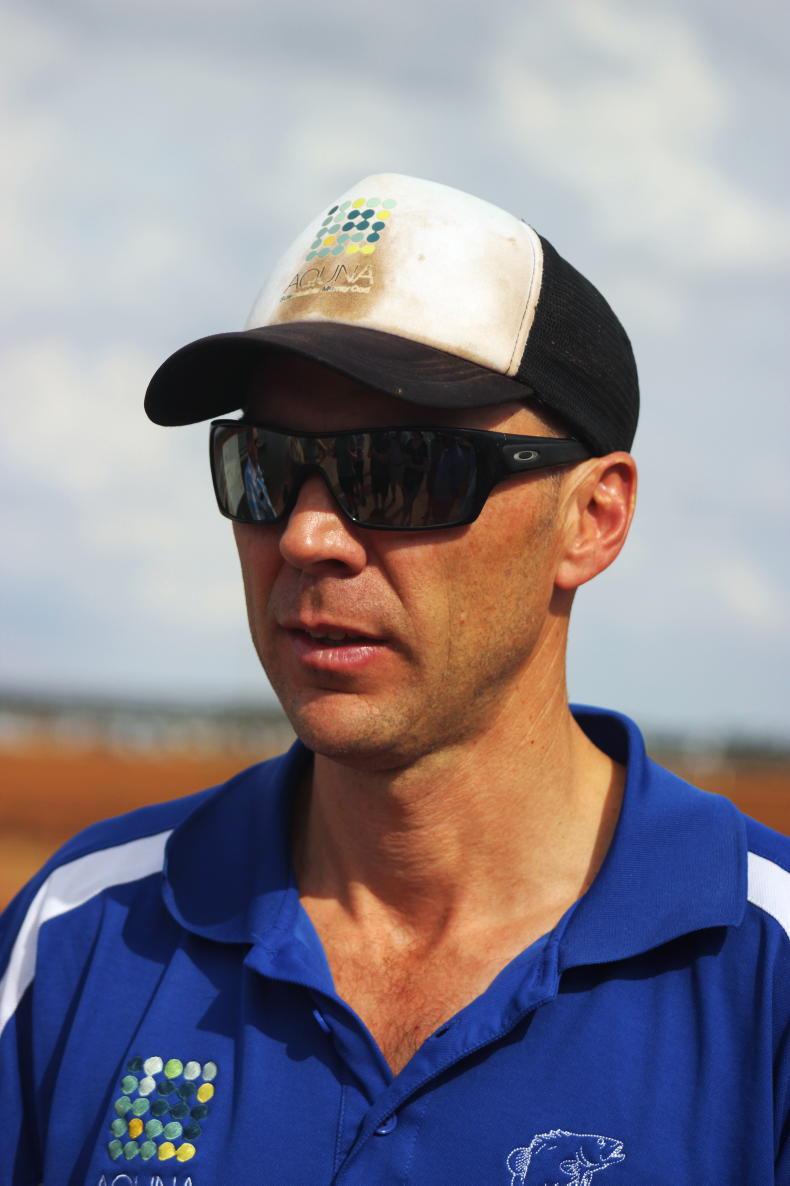
Matt Ryan explained the workings of the Murray Cod fish farm to the ITLUS group.
Weather challenges made this profession very difficult and encouraged him to consider a career change.
He said that his inclination had always been to look towards aquaculture. In late 2011, he made the decision to set up a fish production business.
Murray Cod Australia is the current business. While ‘cod’ is the name featured, Matt said that the species he is producing is actually a freshwater perch, which can grow up to 1.2m in length.
The particular species was native, but was fished to extinction existence. There had been previous attempts to farm the fish, but they all failed.
Matt commented that the main reason for this was that all previous attempts were based on it being a secondary enterprise. He is of the view that if it is not a primary enterprise, it will not succeed.
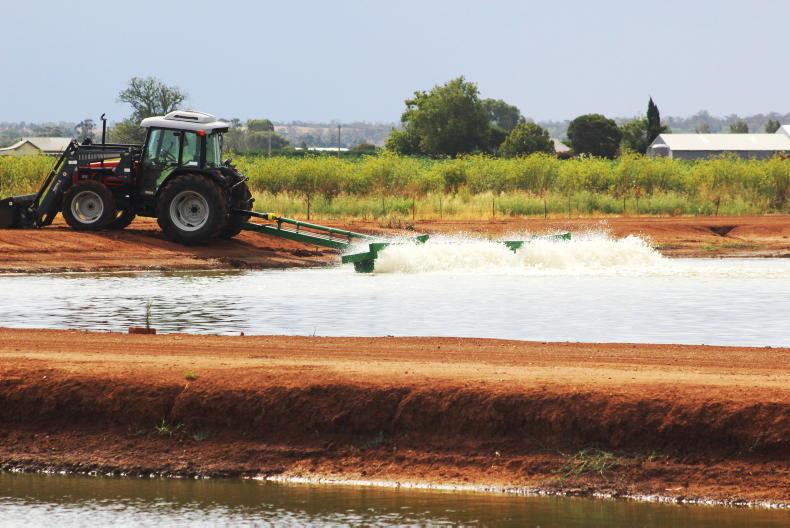
A tractor PTO-driven device to oxegenate the water in one of the ponds in which the fish are growing.
By 2016, he had three fishponds in production. By then, he realised that he either needed to grow or to quit.
It takes two years to grow the fish to saleable size, so banks had little interest in funding his expansion. So he took matters in his own hands and listed the company on the stock market to generate funding.
The business now has 28 ponds and when we visited in January 2020, he hoped to be producing 1,000t per year by the end of 2022.
The company has gone through several developmental and expansion changes since its conception.
Having been one of three investors at the start, their combined shareholding is now less than 50% of the business and Matt’s own shareholding was down to 20%.
But the business had grown to be an AUS$8 to $9m turnover business per year. And the intention was to continue growing.
Spawning
The particular species of fish spawn naturally in the ponds. When they are fertilised, the females spawn on nets within the pond.
Once spawning is finished, the nets are lifted out and the spawn on the fingerstrings are transferred to the hatchery, where they are hatched out to become fry.
At this point, the little fry are placed in specific ponds that contain lots of insect larvae and these alone become their food source for the next few months.
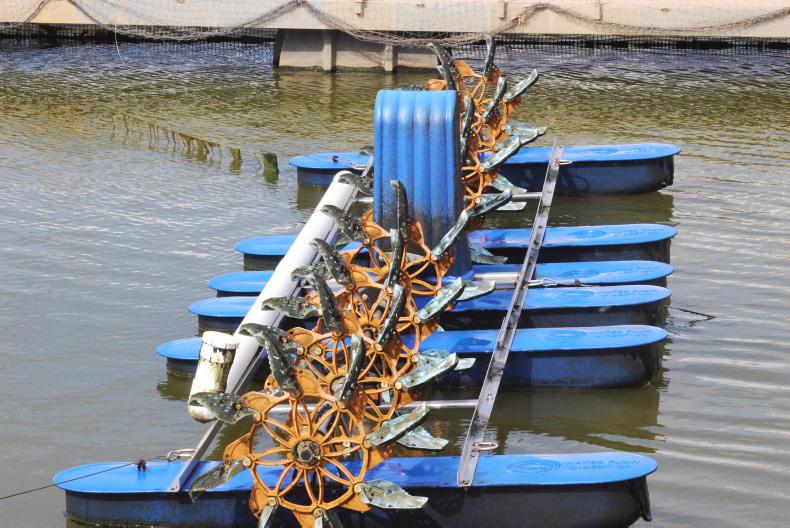
A set on the splash padals used to splash and aerate the water in the ponds.
The fish only breed in September/October, ie in spring, as water temperatures begin to increase. Matt commented that this fish species is aggressive and predatory by nature, especially when young.
When they are around three months old, they are moved on to an artificial feed diet.
After they get used to that, they are moved into growing ponds when they are about 10 to 12 centimetres in length.
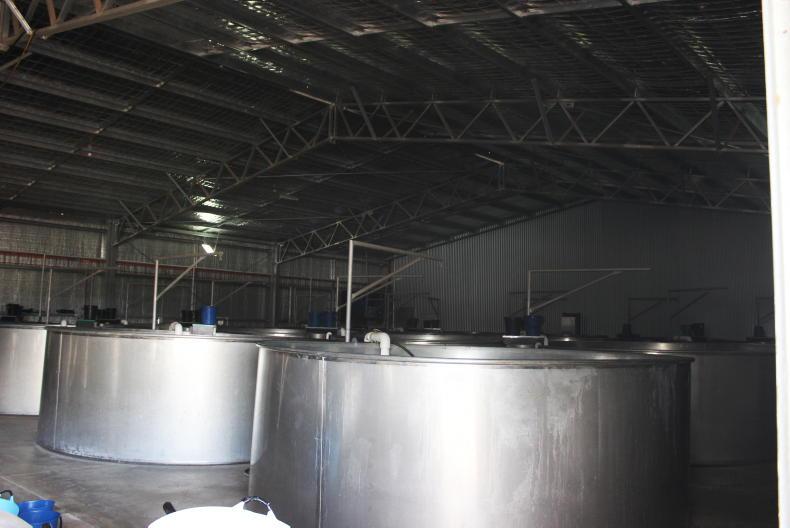
One of the indoor rearing houses for the young fish which holds quite a number of circular tanks. It is essential to have some light in these houses to help make the fish less aggressive.
Matt commented that there are only two hatcheries that can supply fingerstrings - the strings of spawn produced by the females. The company owned one of these and is considering purchasing the second.
Specialised equipment
Operating an aquaculture business in the middle of a dry state in a dry country does not lend itself to competitive access to aquaculture equipment.
As an example, Matt said a specialist aquaculture pump could cost in the order of AUS$800,000 to AUS$900,000, while a standard pump was priced around AUS$30,000 to AUS$40,000.
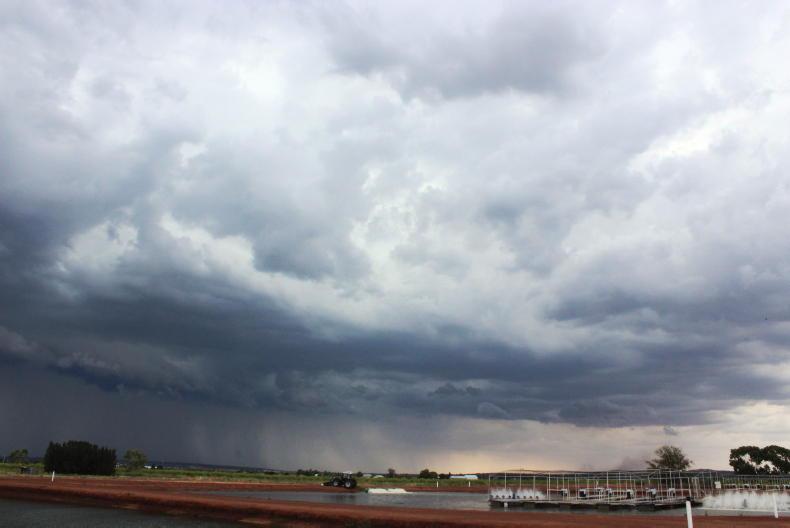
An overview of one of the ponds with a number of different oxygenating systems operating, the fish tanks covered with nets and a thundering big shower falling in the background.
For this reason, much of the equipment used on the farm was made locally for a specific purpose.
While water pumps might be the most obvious equipment requirement, the farm also needs a lot of other specialist equipment, such as the equipment used to aerate the water to keep it healthy for the fish.
Marketing
Most of the fish are sold at between 2.0kg and 2.5kg in weight.
About 70% of the product goes to the domestic market, with 30% exported. Some of this is going to Europe (Switzerland and Germany).
He uses a brand ambassador to help with marketing because he said that his biggest challenge is the perception that freshwater fish did not have a good name in the food business. However, he has managed to change this.
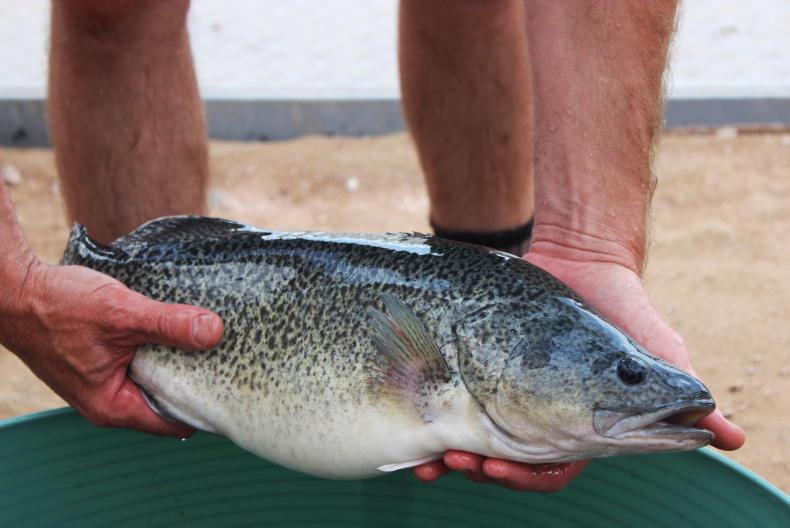
One of the fish growing in the fish ponds.
When we visited, Matt said that the fish wholesale at about AUS$20/kg, putting it at the high end of the market.
One of Matt’s major objectives was to avoid commodity selling, regardless of what he was producing. The fish are marketed under the Acuna brand – the Aboriginal word for flowing water.
The fish are sold fresh, but may be frozen to get them to market. Fish are harvested on Thursday for the European market, where they arrive on Friday morning.
Matt commented that at the height of the fires, transport and logistics became a particular challenge in December 2019 and January 2020.
He also supplies young fish for the purpose of restocking rivers, as this species was native to many rivers in the region.
Labour
In spring 2020, there were 30 staff working at Murray Cod Australia.
Interestingly, there was an increasing dependence on backpackers or casual workers who need rural work to secure visa applications.
Matt said that individual workers are normally assigned six months experience on an individual task and then changed to get a fuller work experience.
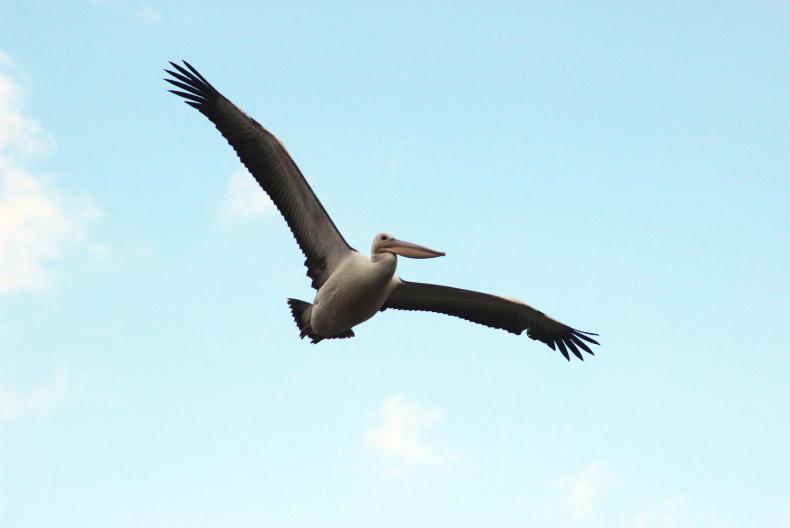
Hoping for a free meal - a pelican hovers over the netted ponds should a fish escape from its enclosure.
At the time, labour cost AUS$25 per hour plus overtime. Workers get paid time and a half for hours beyond a 10-hour day.
Other facts
Different aspects of the production system take place inside and outside.
For the indoor work, the shed is insulated, but not climate-controlled, as the fish need some access to light.
This is important because the light is important for melatonin production, which acts to decrease aggression in the young fish.
While he is at the high end of the market, Matt commented that the fish are not organic, because the feed which he is giving to them is not organic.
When we visited, there were about 750,000 fish being reared indoors in the sheds and that was only half working capacity.
Feed availability was the major limitation at the time, as everything was scarce following three years of drought.
The fish that are indoors were being fed manually, but those in the outdoor ponds were being fed automatically.
Handling, grading, etc, are mainly manual tasks, but Matt now has some semi-mechanical systems installed to help with some of these tasks.
Having spent 10 days touring through drought-stricken Western Australia (WA) and central parts of New South Wales (NSW), it was somewhat of an eye-opener when the Irish Tillage and Land Use Society (ITLUS) tour ended up in a fish farm in Bilbul just east of Griffith, NSW.
Griffith is in the Riverina region, which is quite unique. Its combination of heat and water availability for irrigation makes it suitable for the production of almost every crop on earth.
It is part of the Murrumbidgee Irrigation Area (MIA), which is the source of water for the area.
The MIA itself was created to control and divert the flow of local river and creek systems to provide water for crop production.
The concept was conceived in the 1880s and began in the early 1900s. It began operating in 1912, following the construction of the first dam.
It is part of the Murray-Darling Basin and covers an area of 378,911ha, of which around 141,000ha is irrigated. Rice is one of the crops grown in the region.
Murray Cod
At the Murray Cod Farm, we met with Matt Ryan. Matt was an agronomist, who had worked in the mainly dryland farming region of NSW.

Matt Ryan explained the workings of the Murray Cod fish farm to the ITLUS group.
Weather challenges made this profession very difficult and encouraged him to consider a career change.
He said that his inclination had always been to look towards aquaculture. In late 2011, he made the decision to set up a fish production business.
Murray Cod Australia is the current business. While ‘cod’ is the name featured, Matt said that the species he is producing is actually a freshwater perch, which can grow up to 1.2m in length.
The particular species was native, but was fished to extinction existence. There had been previous attempts to farm the fish, but they all failed.
Matt commented that the main reason for this was that all previous attempts were based on it being a secondary enterprise. He is of the view that if it is not a primary enterprise, it will not succeed.

A tractor PTO-driven device to oxegenate the water in one of the ponds in which the fish are growing.
By 2016, he had three fishponds in production. By then, he realised that he either needed to grow or to quit.
It takes two years to grow the fish to saleable size, so banks had little interest in funding his expansion. So he took matters in his own hands and listed the company on the stock market to generate funding.
The business now has 28 ponds and when we visited in January 2020, he hoped to be producing 1,000t per year by the end of 2022.
The company has gone through several developmental and expansion changes since its conception.
Having been one of three investors at the start, their combined shareholding is now less than 50% of the business and Matt’s own shareholding was down to 20%.
But the business had grown to be an AUS$8 to $9m turnover business per year. And the intention was to continue growing.
Spawning
The particular species of fish spawn naturally in the ponds. When they are fertilised, the females spawn on nets within the pond.
Once spawning is finished, the nets are lifted out and the spawn on the fingerstrings are transferred to the hatchery, where they are hatched out to become fry.
At this point, the little fry are placed in specific ponds that contain lots of insect larvae and these alone become their food source for the next few months.

A set on the splash padals used to splash and aerate the water in the ponds.
The fish only breed in September/October, ie in spring, as water temperatures begin to increase. Matt commented that this fish species is aggressive and predatory by nature, especially when young.
When they are around three months old, they are moved on to an artificial feed diet.
After they get used to that, they are moved into growing ponds when they are about 10 to 12 centimetres in length.

One of the indoor rearing houses for the young fish which holds quite a number of circular tanks. It is essential to have some light in these houses to help make the fish less aggressive.
Matt commented that there are only two hatcheries that can supply fingerstrings - the strings of spawn produced by the females. The company owned one of these and is considering purchasing the second.
Specialised equipment
Operating an aquaculture business in the middle of a dry state in a dry country does not lend itself to competitive access to aquaculture equipment.
As an example, Matt said a specialist aquaculture pump could cost in the order of AUS$800,000 to AUS$900,000, while a standard pump was priced around AUS$30,000 to AUS$40,000.

An overview of one of the ponds with a number of different oxygenating systems operating, the fish tanks covered with nets and a thundering big shower falling in the background.
For this reason, much of the equipment used on the farm was made locally for a specific purpose.
While water pumps might be the most obvious equipment requirement, the farm also needs a lot of other specialist equipment, such as the equipment used to aerate the water to keep it healthy for the fish.
Marketing
Most of the fish are sold at between 2.0kg and 2.5kg in weight.
About 70% of the product goes to the domestic market, with 30% exported. Some of this is going to Europe (Switzerland and Germany).
He uses a brand ambassador to help with marketing because he said that his biggest challenge is the perception that freshwater fish did not have a good name in the food business. However, he has managed to change this.

One of the fish growing in the fish ponds.
When we visited, Matt said that the fish wholesale at about AUS$20/kg, putting it at the high end of the market.
One of Matt’s major objectives was to avoid commodity selling, regardless of what he was producing. The fish are marketed under the Acuna brand – the Aboriginal word for flowing water.
The fish are sold fresh, but may be frozen to get them to market. Fish are harvested on Thursday for the European market, where they arrive on Friday morning.
Matt commented that at the height of the fires, transport and logistics became a particular challenge in December 2019 and January 2020.
He also supplies young fish for the purpose of restocking rivers, as this species was native to many rivers in the region.
Labour
In spring 2020, there were 30 staff working at Murray Cod Australia.
Interestingly, there was an increasing dependence on backpackers or casual workers who need rural work to secure visa applications.
Matt said that individual workers are normally assigned six months experience on an individual task and then changed to get a fuller work experience.

Hoping for a free meal - a pelican hovers over the netted ponds should a fish escape from its enclosure.
At the time, labour cost AUS$25 per hour plus overtime. Workers get paid time and a half for hours beyond a 10-hour day.
Other facts
Different aspects of the production system take place inside and outside.
For the indoor work, the shed is insulated, but not climate-controlled, as the fish need some access to light.
This is important because the light is important for melatonin production, which acts to decrease aggression in the young fish.
While he is at the high end of the market, Matt commented that the fish are not organic, because the feed which he is giving to them is not organic.
When we visited, there were about 750,000 fish being reared indoors in the sheds and that was only half working capacity.
Feed availability was the major limitation at the time, as everything was scarce following three years of drought.
The fish that are indoors were being fed manually, but those in the outdoor ponds were being fed automatically.
Handling, grading, etc, are mainly manual tasks, but Matt now has some semi-mechanical systems installed to help with some of these tasks.











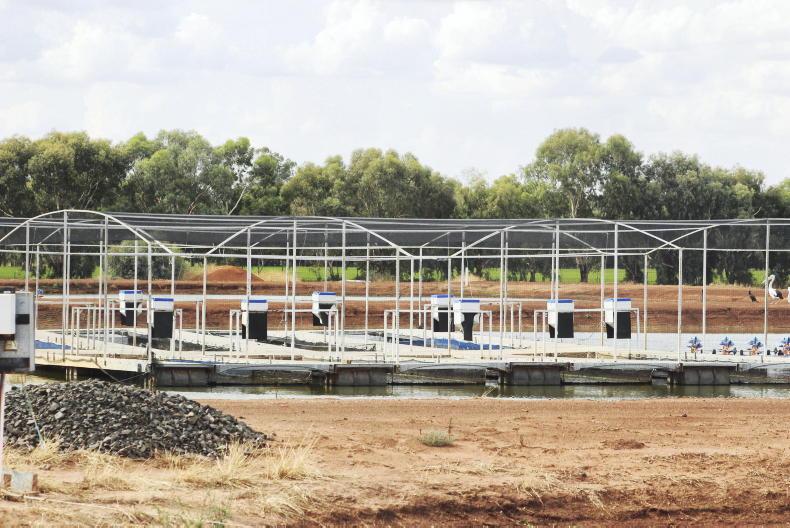
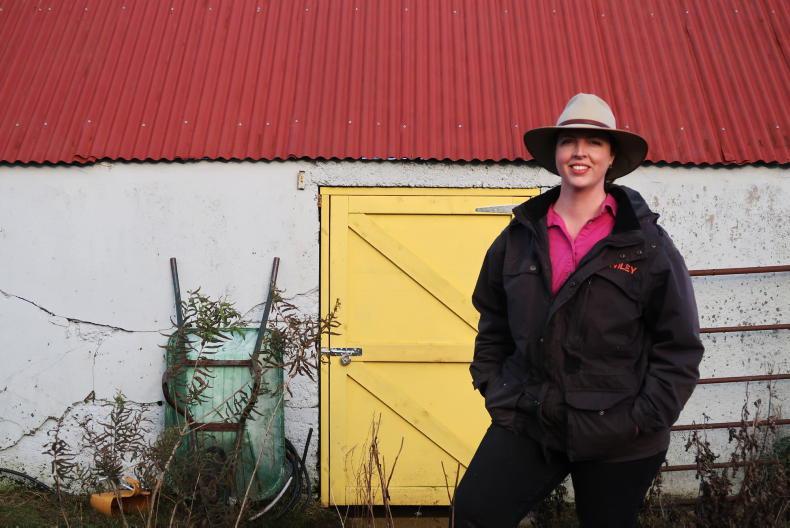
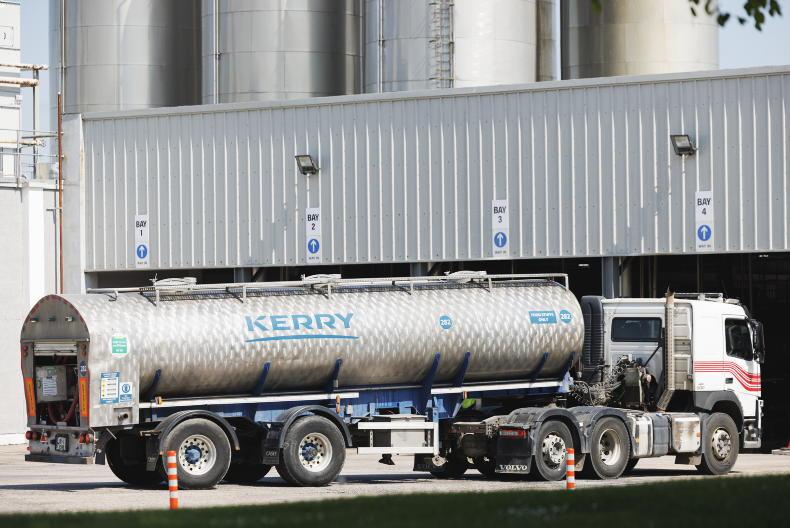

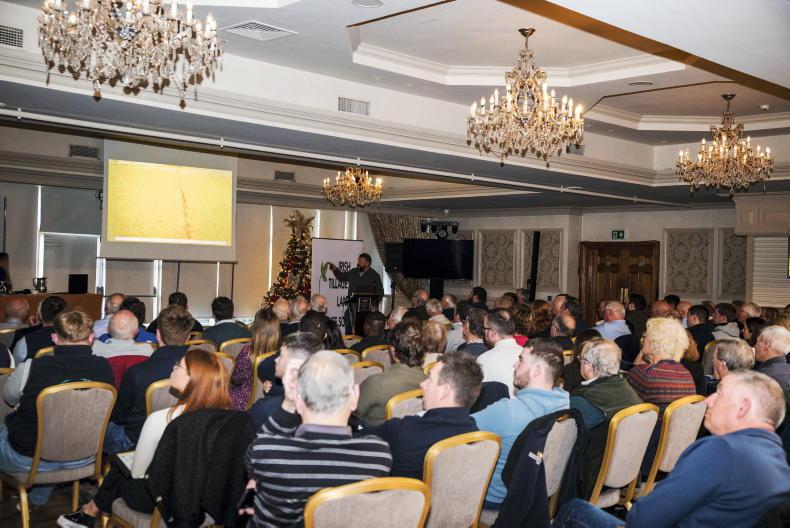
SHARING OPTIONS